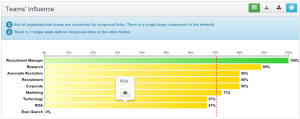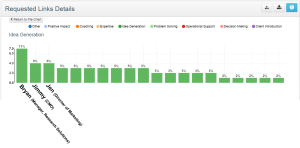DNA-7 – Changing the Way We See HR Technology
I had the pleasure of meeting CEO of DNA-7, Eyal Steiner and not only is he globe trotter bringing something very valuable to us in the United States, the technology from DNA-7 provides a whole new way to analyze how information flows through an organization. With communication breakdowns being behind most barriers to performance and productivity for people, this tool is sure to help businesses be proactive in identifying communication breakdowns, bottlenecks and more.
Having a positive Human Resources experience is rare for most companies. Let’s first admit that. Yes, HR has gone a long way in recent years to reinvent itself as an entity that supplies decision-making data and metrics about talent and workforce, however, for the most part our interaction with HR is transactional and worst of all – there is a huge disparity between the operational needs of our organization and the way HR handles the needs – how often is the person that was just hired not really what we needed? How often does orientation and onboarding achieve very little?
With that experience, we often seek the assistance of consultants, who have been executives themselves in a past lifetime to help us re-structure our organization, build recruitment strategies and handle training in a more efficient way, and help integrate talent management into the core of the organization. In other cases, we seek to outsource our HR operations completely, or different parts of it (performance reviews, recruiting, etc.), as it allows real HR professionals who know what it takes to run an organization to deal with some of our most significant functions.
When we outsource our HR functions, we receive another huge boon – vast exposure to HR technology. Our ability to research and explore HR technology is very limited (or any technology for that matter), but HR outsourcers are exposed to nearly everything the market has to offer, and can then recommend and advise us on HR technology that can solve a real problem we have. They have seen the technology in action, they may have used it themselves, and they bring to the table an added value that is hard to measure.
The HR technology market is very fragmented and vendors are offering different (or similar) solutions to common problems and practices, while very rarely we encounter new technology that solves problems we didn’t know we have or we had a hard time imagining how they can even be solved. Social and organizational network analysis has been a common practice in the academy, mainly in mathematics and computer science, for over four decades now. With the ascension of social networks like Facebook or LinkedIn, the understanding of their power to gain insights into how very complex systems work quickly led to the understanding of the vital role they can play for organizations.
With that in mind, DNA-7 was developed – the power to understand, quantify, and visualize how managers and employees collaborate within the organization, see collaboration gaps, and receive insights into how we can bridge collaboration gaps. These networks can also serve to better analyze our leaders – who they really are (regardless of formal power within the organization)? What kind of influence do they have across the organization? Why are other employees seeking to work with them?
This information is useful for nearly all our HR operations – starting from organization and leadership development, throughout executive training and onboarding (and what’s more useful for onboarding executives than getting a map of how information travels in their organization and where the centers of power and influence within their organization are?), align HR with the entire organization, and to a lesser extent pinpoint recruitment needs.
But more than that, it positions HR in a place of creating knowledge for the rest of the organization, rather than dealing mostly with compliance issues and problem solving. This means that perhaps for the first time, we don’t only understand and accept that talent in our organization is what drives our organization forward, but we also allow that talent to actively participate in creating information and knowledge that will, in turn, help us manage the talent in a more accurate and integrative fashion.
In conclusion, while past interactions with HR have almost always left a bitter taste in our mouths, it doesn’t have to stay that way. New practices and new technologies for HR finally allow us to manage our talent better, harvest the knowledge they have (directly or indirectly), present that information in new and innovative ways, including organizational maps that take into consideration the extreme complexity that is our organization, where common organizational charts just can’t. These advances mean that HR is quickly moving forward to become strategic partners in our process to gain the most from our talent and workforce – and that might be our end-game for HR – professionals who know talent actually dealing with our talent.



